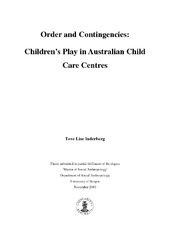| dc.description.abstract | In this thesis I explore children's play in two Australian child care centres. What is presented here is an analysis of children's experiences and some of the diverse ways in which children constitute their own ideas and knowledge of the world. I argue that the alternative versions of reality which feature in the imaginary worlds and narratives that the children playfully create provide a way of commenting and reflecting upon the everyday world. However, one must also treat seriously that children's relations are created largely out of play. While play is a realm in everyday life in the child care centre in which children can have some authority over worlds of meaning, play is also part of pedagogy and part of subject formation. The child care centre is part of wider social structure, and children are introduced to the discipline that will organise their lives in schools and later in the workplace. The sharing of common rules and routines in the child care centre between the children creates a common world of meaning between them. Rules and routines are enforced by teachers, and while children to some extent do form a self-policing community they also find ways to bend and negotiate the rules even in highly organised pedagogic activities. The ethnography shows how children find ways of subverting the adult-dominated, common sense world, but they also embrace the forms of stability and security it offers, and much of their own renegotiations with each other involve a reinvention of the boundaries of common sense in unexpected ways. Children's imaginary worlds relate to the real' world not just by replicating, but through transforming and transgressing the real. I argue that the incorporation of aspects of everyday life and the real world in play often does not involve a total reinvention, but is, rather, a process of continual appropriation and re-contextualisation. This shows features of order and contingencies in children's play: how their imaginary worlds are not completely random and haphazard, but have regularity in that they can be seen as related to the real world - though not in ways which are always obvious and simple. | en_US |
